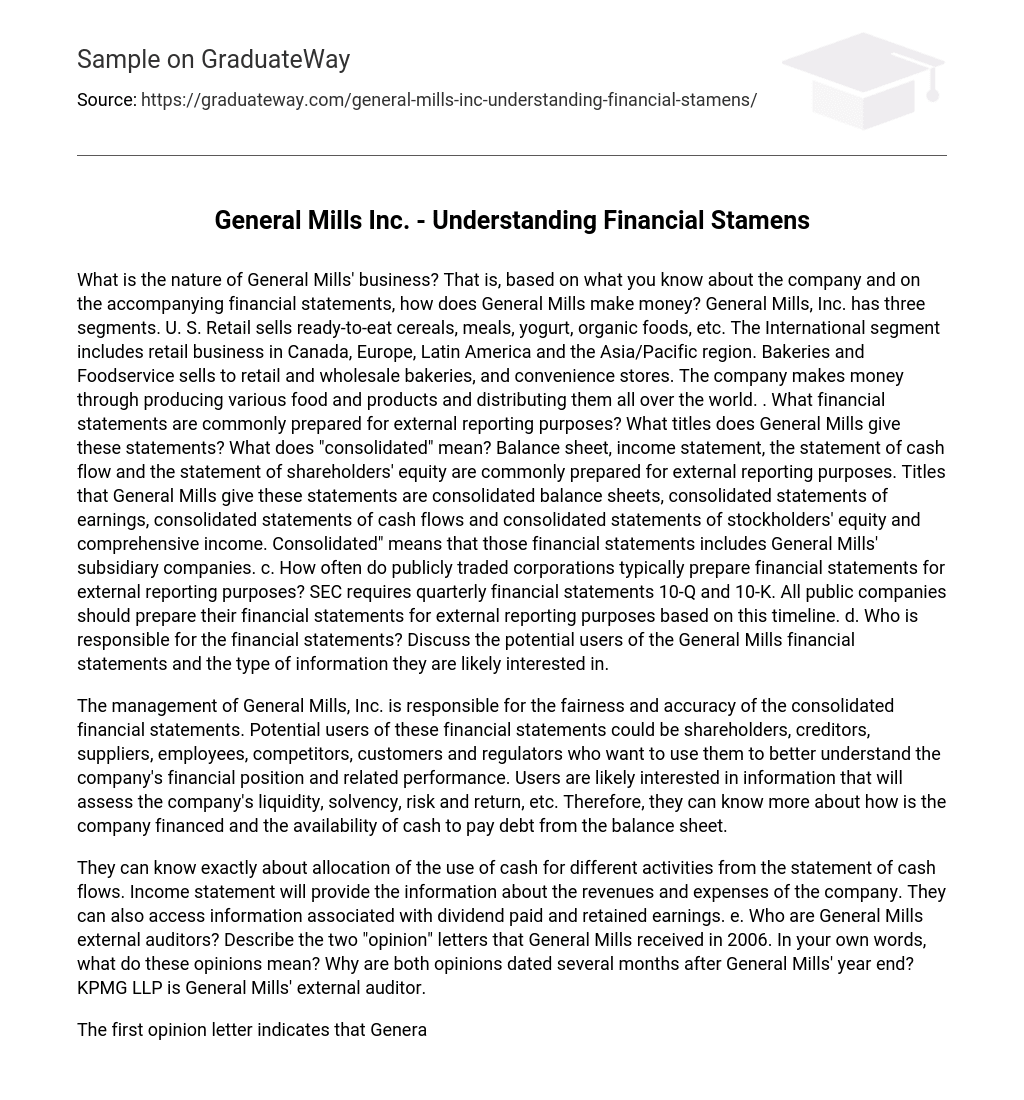Publicly traded corporations are required by the SEC to prepare financial statements for external reporting purposes. These statements include quarterly financial statements (10-Q) and annual financial statements (10-K). It is the responsibility of companies like General Mills to adhere to the specified timeline in preparing these statements. The financial statements serve different interests for various potential users.
General Mills, Inc. guarantees the honesty and precision of its consolidated financial statements, which are important for a range of users such as shareholders, creditors, suppliers, employees, competitors, customers, and regulators. These individuals rely on these financial statements to obtain a comprehensive comprehension of the company’s financial position and performance. Users are particularly interested in assessing the company’s liquidity, solvency, risk, and return. By analyzing the balance sheet, users can determine how the company is funded and its capacity to settle debts using available cash.
The statement of cash flows provides detailed information on how cash is allocated for various activities. The income statement shows the company’s revenues and expenses, as well as dividend payments and retained earnings. General Mills relies on KPMG LLP as its external auditor. In 2006, the company received two “opinion” letters, which express an auditor’s evaluation of a company’s financial statements. These opinions are issued several months after General Mills’ year end to allow for the completion of necessary auditing procedures and to ensure the accuracy of the financial information provided.
The first opinion letter attests to the effective internal control maintained by General Mills and its subsidiaries. On the other hand, the second opinion letter discusses how KPMG has conducted an examination of the company’s consolidated financial statements and financial statement schedule. The public accounting firm affirms that General Mills’ financial statements are accurately presented in terms of material aspects and comply with the criteria of U.S. GAAP. These opinions indicate that the company has adhered to GAAP regulations and accurately reported the financial performance of each relevant item.
The company’s consolidated financial statements were publicly disclosed in late May, along with the auditor reports on July 27, 2006. The accounting firm provided their opinion on that date. General Mills primarily utilizes long-term debt to support its assets for financing its operations. The balance sheet reveals that a significant portion of total liabilities consists of both current and long-term debt. Sources other than owners contribute approximately 31.7% to the company’s overall funding. Note 1 details General Mills’ policies regarding revenue recognition, ensuring compliance with GAAP criteria for net sales, returns, and promotions handling. Revenue is recognized by General Mills when customers accept shipments, which typically occurs upon realization or realizable earnings. In this specific instance, revenue is recognized as it becomes realizable during completed transactions where customers take ownership upon receiving shipments.
Thus, this is in line with the revenue recognition criteria under GAAP. As per Note 1, sales are reported net of consumer coupon, trade promotion, and other costs, including estimated returns. General Mills has specific policies for each scenario as explained in the note. Expenses related to coupons and trade promotions are based on estimates. The company typically does not allow returns, which are recorded as reductions in selling prices. These practices align with the revenue recognition criteria under GAAP. In fiscal 2005, General Mills reports the following three items separately: restructuring and other exit costs, divestitures, and debt repurchase costs. Why did the company not include all of these amounts within the line item for selling, general, and administrative expenses? Restructuring and other exit costs, divestitures, and debt repurchase costs are considered non-ordinary items as they do not occur regularly. Hence, they are presented separately from selling, general, and administrative expenses.
Selling, general, and administrative expenses are regular expenditures that arise from ongoing operations and are therefore relatively consistent and predictable. On the other hand, irregular costs can vary from year to year, and if left unadjusted, they can generate confusion among users of financial reports. A case in point is General Mills in 2005 when they incurred substantial expenses related to debt repurchases, restructuring, and other exit costs, leading to a decrease in their net earnings. However, the company also made significant divestments that offset the impact on their net income.
The financial statements of General Mills contain several notes that mention the use of “estimates.” Some accounts on the company’s balance sheet that require estimates are as follows: 1) Receivable – when presenting net receivable account, the company should deduct allowance for bad debts, which are estimated amounts. 2) Inventory – cost needs to be estimated at the end of the year to recalculate the value of the inventory. 3) Land, Buildings, and Equipment – depreciation expense is calculated based on straight-line or other methods. 4) Current liabilities – companies estimate the amount they owe for bills that they haven’t received or paid. 5) Long-term debt – estimation is used to determine the amount of debt to be paid off during each period and record it. Almost all types of accounts involve some degree of estimation, particularly when the amount is significant. Users of financial statements should pay attention to notes disclosing the estimating method and how it impacts the company’s financial performance.





